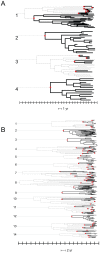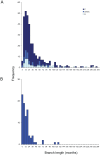Molecular phylodynamics of the heterosexual HIV epidemic in the United Kingdom
- PMID: 19779560
- PMCID: PMC2742734
- DOI: 10.1371/journal.ppat.1000590
Molecular phylodynamics of the heterosexual HIV epidemic in the United Kingdom
Abstract
The heterosexual risk group has become the largest HIV infected group in the United Kingdom during the last 10 years, but little is known of the network structure and dynamics of viral transmission in this group. The overwhelming majority of UK heterosexual infections are of non-B HIV subtypes, indicating viruses originating among immigrants from sub-Saharan Africa. The high rate of HIV evolution, combined with the availability of a very high density sample of viral sequences from routine clinical care has allowed the phylodynamics of the epidemic to be investigated for the first time. Sequences of the viral protease and partial reverse transcriptase coding regions from 11,071 patients infected with HIV of non-B subtypes were studied. Of these, 2774 were closely linked to at least one other sequence by nucleotide distance. Including the closest sequences from the global HIV database identified 296 individuals that were in UK-based groups of 3 or more individuals. There were a total of 8 UK-based clusters of 10 or more, comprising 143/2774 (5%) individuals, much lower than the figure of 25% obtained earlier for men who have sex with men (MSM). Sample dates were incorporated into relaxed clock phylogenetic analyses to estimate the dates of internal nodes. From the resulting time-resolved phylogenies, the internode lengths, used as estimates of maximum transmission intervals, had a median of 27 months overall, over twice as long as obtained for MSM (14 months), with only 2% of transmissions occurring in the first 6 months after infection. This phylodynamic analysis of non-B subtype HIV sequences representing over 40% of the estimated UK HIV-infected heterosexual population has revealed heterosexual HIV transmission in the UK is clustered, but on average in smaller groups and is transmitted with slower dynamics than among MSM. More effective intervention to restrict the epidemic may therefore be feasible, given effective diagnosis programmes.
Conflict of interest statement
The authors have declared that no competing interests exist.
Figures




References
-
- Anonymous Human immunodeficiency virus infection in the United Kingdom: quarterly report I. The epidemic to 30 September 1987. J Infect. 1988;16:291–302. - PubMed
-
- Ludlam CA, Tucker J, Steel CM, Tedder RS, Cheingsong Popov R, et al. Human T-lymphotropic virus type III (HTLV-III) infection in seronegative haemophiliacs after transfusion of factor VIII. Lancet. 1985;2:233–236. - PubMed
-
- Leigh Brown AJ, Lobidel D, Wade CM, Rebus S, Phillips AN, et al. The molecular epidemiology of human immunodeficiency virus type 1 in six cities in Britain and Ireland. Virology. 1997;235:166–177. - PubMed
-
- Wade CM, Lobidel D, Leigh Brown AJ. Analysis of human immunodeficiency virus type 1 env and gag sequence variants from a mother and two verticaly infected children provides evidence for the transmission of multiple sequence variants. J Gen Virol. 1998;79:1055–1068. - PubMed
Publication types
MeSH terms
Substances
Grants and funding
LinkOut - more resources
Full Text Sources
Medical
Molecular Biology Databases

